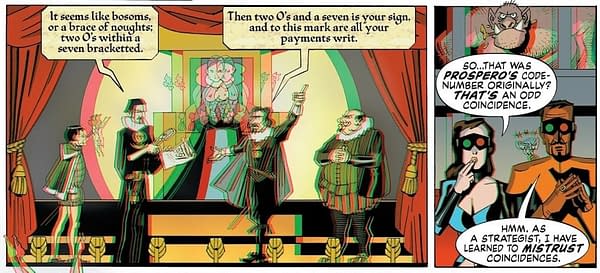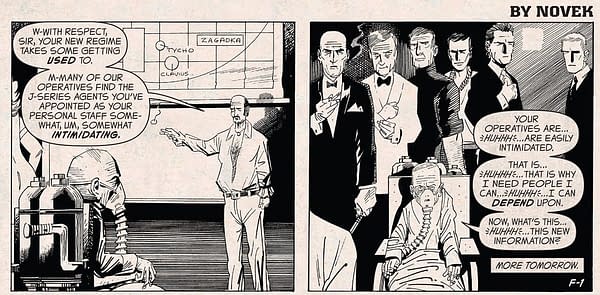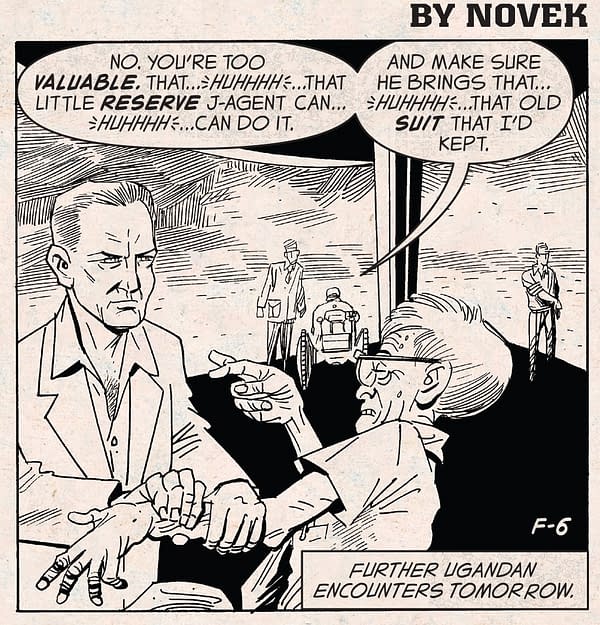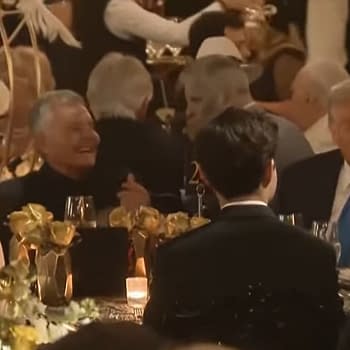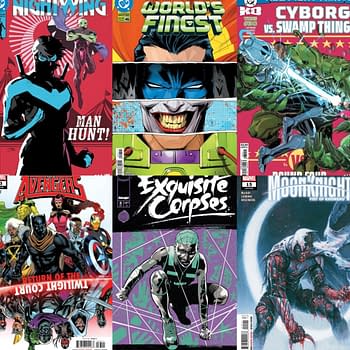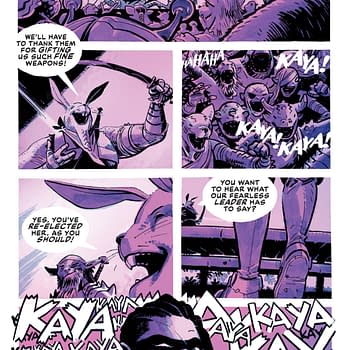Posted in: Comics | Tagged:
The Death of James Bond,or at Least One of Him, in League Of Extraordinary Gentlemen: Tempest Book Four
Once upon a time, Don Murphy, the film producer of the League Of Extraordinary Gentlemen movie who had fallen out with Alan Moore, took a walk with then-Wildstorm President-now-Marvel Publisher John Nee, to talk about DC's upcoming plans to publish The League Of Extraordinary Gentlemen: The Black Dossier. And told him all the issues he was going to have with the book, legally, especially involving the appearance of one Jimmy Bond, coded as Ian Fleming's James Bond.
That's how the story goes, anyway.
As a result, many changes were fought over the book with the creative team of Alan Moore and Kevin O'Neill. Aspects of the book were amended and dropped, while others were fought for and defended. The promised record was scrapped. And in the fallout, Wildstorm editor Scott Dunbier was fired. He popped up at IDW a few laters later.
The League left DC and popped up at Top Shelf. IDW bought Top Shelf. A new edition of the Black Dossier was issued from Knockabout and Gosh Comics with the record.
No one sued.
And now, the final issues of the final League Of Extraordinary Gentlemen comic Tempest have more James Bond than ever before. Jimmy Bond became M, grew ancient, entered the fountain of youth and returned to look as the original image drawn by Fleming, before nuking the Fountain of Youth, and then the hideaway dimension for all the madness of the world retreating from the twentieth and twenty-first centuries, The Blazing World, ruled over by Prospero – the originator of Prospero's Men, the original League.
And the cover of Book Four sums up the whole adventure so far in the manner of Leo Baxendale's Minnie The Minx from the Beano, reinvented as Mina The Minx with Mina Harker – or Wilhemina Murray depending on your perspective.
With the British kids cartoon strip continuing inside with seventies TV agent Jason King of Department S, compromised by Leaguer Emma Knight (better known as Emma Peel of the Avengers) in the previous issue to attempt an assassination of James Bond, but using the tropes of such strips and stylings to do so.
While in the Blazing World, we see a performance of the William Shakespeare play that was first seen in The Black Dossier, Faeries Fortunes Founded…
…in which Queen Gloriana creates Prospero's Men, who will include Ariel, Caliban, Orlando, Robert Owemuch, Don Quixote, Amber St. Clair and Christian. And names Prospero as the first 007.
In previous issues of Tempest we have seen the original James Bond, dealing with others who have used that name – resembling all the major screen actors who have played Bond…
…and even Woody Allen who played Jimmy Bond in the original Casino Royale, the parody-but-official Bond film that revealed that James Bond was a legacy title.
In Tempest Book Four, they return and are given their collective name. J-Force Six.
Not only does that us a Bond with an outrageous Scottish accent, but the nicknames reframe the different Bonds as both The Spice Girls but also a reference to Fox Force Five, the fictitious TV pilot from the movie Pulp Fiction. With Don Murphy being a producer of Natural Born Killers and also at one point being at odds with Quentin Tarantino, this feels a deliberate confluence. I also mistrust coincidences…
Sorry J-Force Five now. Sean Connery is the first Bond to go, as King's assassination attempt is defeated. In the previous issue, King also revealed that Norton was returning. The Prisoner Of London as created by Alan Moore's friend Ian Sinclair (and illustrated by Dave McKean) in Slow Chocolate Autopsy returns to join Jerry Cornelius, written by Michael Moorcock, to say a farewell to London.
No copyright-evading words needed here, these are official appearances, with permission granted. Authorised sequels, you might say.
And a final appearance of the 'vegetative Buddha' from Sinclair's novel The Last London, which Moore talks about here. There's very much the idea that London is changing beyond recognition, what was London has disappeared, so that Norton is no longer a prisoner of it. This is echoed in much of the League storyline over the decades, despairing that the age of wonder has been replaced by one of mercurial commerce, fascism over anarchy, corporation over culture. Previous LOEG volume Century saw that embodied by Harry Potter representing crass commercial pop culture and a dumbing down of the populace, in Tempest it seems to be Bond, representing government, control, privilege and the subservience demanded.
It's an argument Moore makes in person as well as in fiction, and it's one I argue against, but I can't deny how wonderfully the case is made. And maybe, just maybe, Prospero and Gloriana saw it all coming.
There are two more League books to go and then all is done. I hope you join me. Glasses on…
LOEG TEMPEST #4
(W) Alan Moore (A/CA) Kevin O'Neill
Legendary swords clash atop the Paris Opera in 1913, while almost a century later a declining London witnesses assassination attempts, summit meetings in Haggerston Park, and the catastrophic return of a 1960s super-adventurer. Elsewhere, in the four-dimensional territories adjacent to the North Pole, a lost Shakespeare play sees its first and last performance, while Queen Gloriana's conjurer finally reveals the nature of his five-hundred-year-old game. Topping off an already heady mixture, this issue's classic Seven Stars reprint depicts our halcyon heroes as "Captives of the Creepyverse," another reason not to miss the unfolding of Moore and O'Neill's fulgurant finale in issue four of The League of Extraordinary Gentlemen, Volume IV: The Tempest.In Shops: Jan 09, 2019 SRP: $4.99





